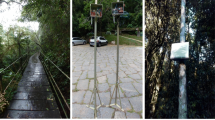Abstract
In this paper, an analytical model for a land mobile satellite channel is introduced that takes into consideration the Generalized Rice model for characterizing the small scale (fast) fading. The proposed model is enriched by the property of non-homogeneous scattering allowing higher flexibility and a more comprehensive description of the channel. In addition, a lognormal process affects the line of sight component, in order to characterize the large scale (slow) fading due to the shadowing effect caused by physical obstacles such as trees and small buildings. The main statistical properties of the model are investigated. Exact solutions for the power spectral density, the probability density function of the envelope and phase, and the cumulative distribution function of the envelope are derived. Approximate solutions for the level crossing rate and the average duration of fades are obtained. The validation of the model is confirmed by simulation and demonstrated by providing the best fit to certain measurement data corresponding to conditions of light and heavy shadowing. As a conclusion, the extended Loo model is applicable in realistic land mobile satellite channels subjected to various conditions and can be preferable because of its outperformance.
Similar content being viewed by others
References
Suzuki H. (1977) A statistical model for urban radio propagation. IEEE Transaction on Communication COM-25(7): 673–680
Hansen F., Meno F. I. (1977) Mobile fading—Rayleigh and lognormal superimposed. IEEE Transactions on Vehicular Technology 26(4): 332–335
Corazza G. E., Vatalaro F. (1994) A statistical model for land mobile satellite channels and its application to nongeostationary orbit system. IEEE Transactions on Vehicular Technology 43(3): 738–742
Patzold M., Killat U., Laue F. (1998) An extended Suzuki model for land mobile satellite channels and its statistical properties. IEEE Transactions on Vehicular Technology 47(2): 617–630
Siqueira, G. L., & Vasquez, E. J. A. (2000). Local and global signal variability statistics in a mobile urban environment. Wireless Personal Communication 15(1), 61–78, Kluwer Academic Publishers.
Loo C. (1985) A statistical model for a land mobile satellite link. IEEE Transactions on Vehicular Technology VT-34(3): 122–127
Patzold M., Li Y., Laue F. (1998) A study of a land mobile satellite channel model with asymmetrical Doppler power spectrum and lognormally distributed line-of-sight component. IEEE Transactions on Vehicular Technology 47(1): 297–310
Abdi A., Lau W. C., Alouini M. S., Kaveh M. (2003) A new simple model for land mobile satellite channels: First and second order statistics. IEEE Transactions Wireless Communications 2(3): 519–528
Vatalaro F. (1995) Generalized rice-lognormal channel model for wireless communications. Electronics Letters 31(22): 1899–1900
Vatalaro F., Mazzenga F., De Maio G., Forcella A. (2002) The generalized rice lognormal channel model-first and second order statistical characterization and simulation. International Journal of satellite communications 20: 29–45 (J Wiley)
Hoyt R. S. (1947) Probability functions for the modulus and angle of the normal complex variate. Bell System Technical Journal 26: 318–359
Zogas D., Karagiannidis G., Kotsopoulos S. (2005) Equal gain combining over Nakagami-n (Rice) and Nakagami-q (Hoyt) generalized fading channels. IEEE Transaction on Wireless Communications 4(2): 374–379
Youssef N., Wang C.-X., Patzold M. (2005) A study on the second order statistics of Nakagami-Hoyt mobile fading channels simulation models for mobile fading channels. IEEE Transactions on Vehicular Technology 54(4): 1259–1265
Youssef, N., Wang, C. X., Patzold, M., Jaafar, I., & Tabbane, S. (2004). On the statistical properties of generalized rice multipath fading channels. Vehicular technology conference 2004. VTC 2004-Spring. 2004 IEEE 59th.
Beckmann P., Spizzichino A. (1987) The scattering of electromagnetic waves from rough surfaces. Artech, Norwood MA
Braun W. R., Dersch U. (1991) A physical mobile radio channel model. IEEE Transactions on Vehicular Technology 40(2): 472–482
Xie Y., Fang Y. (2000) A general statistical channel model for mobile satellite systems. IEEE Transactions on Vehicular Technology 49(3): 744–752
Patzold, M., Killat, U., Laue, F., & Li, Y. (1996). A new and optimal method for the derivation of deterministic simulation models for mobile radio channels. Proceedings IEEE 46th vehicular technology conference VTC 96, Atlanta, Georgia, USA, 1423–1427
Patzold M. (2002) Mobile fading channels. Wiley, Chichester
Papoulis A. (1991) Probabilities, random variables and stochastic processes (3rd ed.). McGraw-Hill, New York
Ohtani K., Daikoku K., Omori H. (1981) Burst error performance encountered in digital land-mobile radio channel. IEEE Transactions on Vehicular Technology VT-23(1): 156–160
Wang H. S., Moayeri N. (1995) Finite state Markov channel—A useful model for radio communication channels. IEEE Transactions on Vehicular Technology VT-44(1): 163–171
Tepedelenlioglu C., Abdi A., Giannakis G. B., Kaveh M. (2001) Estimation of Doppler spread and signal stength in mobile communications with applications to handoff and adaptive transmission. Wireless Communications and Mobile Computing 1(2): 221–242
Rice S.O. (1945) Mathematical analysis of random noise. Bell System Technical Journal 23: 282–332
Jakes W. C. (1993) Microwave mobile communications. IEEE Press, Piscataway, NJ
Butterworth, J. S., & Matt, E. E. (1983). The characterization of propagation effects for land mobile satellite services. In Internatonal conference on satellite systems for mobile communication and avigations, Jun. 1983, pp. 51–54.
Smith, H., Barton, S. K., Gardiner, J. G., & Sforza, M. (1992). Characterization of the land mobile-satellite (LMS) channel at L and S bands: Narrowband measurements. Bradford, ESA AOPs 104 433/114 473
Kanatas, A., Papadakis, N., Chatzopoulos, P., Sofos, T., & Constantinou, P. (1997). Land-mobile satellite channel measurements in Athens City center at 1800 MHz: Proceedings of the 1997 international mobile satellite conference, Pasadena, CA (pp. 169–175). 16–18 June.
Author information
Authors and Affiliations
Corresponding author
Rights and permissions
About this article
Cite this article
Papazafeiropoulos, A.K., Kotsopoulos, S.A. An Extended Loo Model with Inhomogeneous Scattering and its Statistical Properties. Wireless Pers Commun 57, 163–180 (2011). https://doi.org/10.1007/s11277-009-9850-9
Published:
Issue Date:
DOI: https://doi.org/10.1007/s11277-009-9850-9




